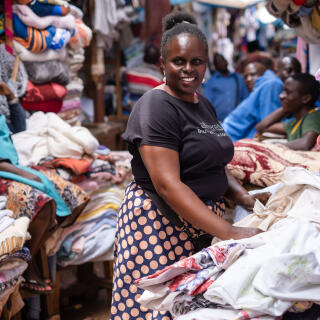


How is Uganda trying to revamp its textile industry? By banning used-clothes imports
FeatureUganda wants to stop importing used clothes, which are extremely popular, in order to develop its textile industry. The decision is in line with the East African regional bloc's directive but has proven challenging for governments to enforce.
"Stop buying second-hand clothes, they are the clothes of the dead!" declared Ugandan President Yoweri Kaguta Museveni at the end of August, as he announced his intention to ban imports of used clothing. The provocative statement did not encounter much opposition: In this poor, landlocked East African country, where little or nothing is bought on a whim, it's not hard to believe that it's end-of-life, rather than consumerism and fast fashion, that drives white people to part with the vast quantities of clothing that flood the region, and more widely the continent. The presidential remark was no doubt intended to steer Ugandan consumers away from these highly popular products.
Entire containers, mainly from the US and Europe, pour into African capitals every day to meet demand. According to a 2015 Oxfam study, 70% of donated clothes end up in Africa. In Nairobi, for instance, markets and street vendors spill out onto the main thoroughfares, sometimes with a few items hanging on a rack or shoes laid out on a large cardboard box. In the Kenyan capital, a long way from France, it's not unusual to come across a passer-by wearing a cap emblazoned with "La Clusaz," a ski resort in Haute-Savoie, or a T-shirt adorned with the unlikely words, "Aquitaine Region."

In Kampala, the capital's vast and bustling Owino market is the nerve center of this trade. In addition to caged chickens, dried fish and kitchen utensils, this huge, frenetic labyrinth is home to thousands of second-hand stalls, specializing in dresses, sportswear, hats and jeans.
Sylivia Namatovu, who is known as "Shareen" having converted to Islam, sells baby clothes starting from 5,000 Ugandan shillings, the equivalent of just over €1. The shopkeeper also stocks some new items but stresses that it's the second-hand ones that sell the quickest: Consumers prefer sturdy and consistently more affordable second-hand options over lower-quality, more expensive Asian designs. "I can sell 10 second-hand pieces for every five new ones," she said, perched on her small stand amid piles of tiny bodysuits and pants.
For the sellers, the announcement rings like a catastrophe, and they choose to believe it only half-heartedly. "If this is the end of second-hand goods, I'll just have to go back to the village," joked this 30-something from the Rakai district in the far south, as she showed a pregnant customer some baby pyjamas – some velvet-lined, despite the tropical heat. A few dozen meters away, 26-year-old Francis Kibalama was selling children's hats. He claimed to earn an average of 200,000 Ugandan shillings a month (€50). "The ban is not good, because it's thanks to these bundles of clothes that we can eat," he said. According to the industry's association, four million people, including importers, wholesalers and small informal retailers, make their living directly and indirectly from second-hand clothes.
You have 70% of this article left to read. The rest is for subscribers only.
